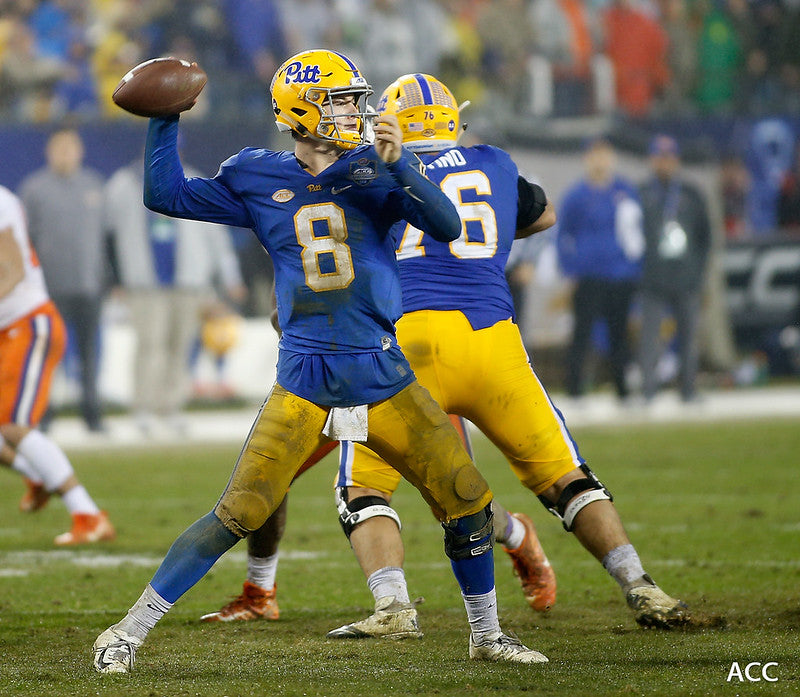Some of the most exciting plays to happen during a football game are pass plays. A good pass play is the fastest way to move the ball down the field and can result in a spectacular highlight.
Pro Tips for Throwing a Football
The first thing to consider when picking up a football is to throw it is the position of the laces in your hand. The laces on a football are important to achieving proper grip and rotation. You should rotate the ball in your hands until the laces fall somewhere around your second and third knuckle on your middle and ring finger. Your pointer finger and thumb will wrap around the front of the ball and will not touch any laces.
The ball should be held with both hands near your head, about shoulder height, and close to your body until you are ready to throw. Once you pick your target, you want to twist your body so that your throwing shoulder is behind you and your front-facing shoulder is aimed at your target.
As you wind up to throw, you should keep your elbow high. As you release the ball, rotate back so that your chest is facing your target. Make sure to follow through on your throw so that your arm is pointed straight at the spot where you want the football to go.
Try to throw a tight spiral where the ball spins smoothly through the air and doesn't wobble or rotate end-over-end to ensure the ball moves as efficiently and accurately as possible.
After enough practice and repetition, throwing a football becomes second nature.
Pro Tips for Catching a Football
There is no point in throwing the football if somebody doesn't catch it! Here are a few tips to help you correctly catch a football that all receivers should know.
One of the biggest things to remember when trying to catch a football is to go get the ball and not just let it come to you. This means your arms and hands should be extended away from your body and towards the ball. This helps ensure that the ball doesn't bounce off your chest, shoulders, or even your head!
When catching a ball, you want to make your hands into a softs basket for the ball to go into. If the ball is above your waist, you want your thumbs to be touching, and if it is below your waist, your pinkies should be touching. Your goal should be for the ball to make as little sound as possible when it hits your hands.
Immediately after catching the football, it is good to practice securing it immediately. After you catch the ball, bring it in close and high on your chest, guarding the ends of the football with your hand and your bicep. This is the best way to ensure you maintain possession of the ball throughout the whole reception.
Pro Tips for Kicking or Punting a Football
A sometimes overlooked but extremely crucial part of the sport is kicking and punting the football. A close game often comes down to a field goal, extra point, or field position, which is why this aspect of football is so important.
When punting a football, hitting the right spot on the ball is crucial for getting good hang time, accuracy, and your desired rotation. The best way to make sure your foot ends up on the right part of the ball is to have a good drop. Some people naturally toss the ball when first attempting to punt, but remember that you are simply dropping the ball and letting it fall directly towards the ground. Dropping the ball in place will make it easier to place your foot correctly underneath the ball.
When dropping the football for a punt, you want to angle one of the pointed ends to the left or right at somewhere around a 25-degree angle. This will help the football to spiral and travel further.
With field goals, extra points, and kickoffs, you usually kick the ball positioned with the pointy ends of the ball pointing up and down. Whether kicking off of a tee or with another player holding the ball, slight adjustments make huge differences in the kicking game.
Some general rules for punting and kicking is that for a further and higher punt, making contact with the roundest middle area of the ball will give you more power. If you hit the ball closer to the end nearest your body, the ball will likely have a forward rotation and bounce or roll forward once it hits the ground.
Lots of practice is the only way to master how the ball will react based on where and how you make contact with it. Keeping some of these tips in mind when first learning about kicking and punting will help you when first learning about these aspects of special team play.

